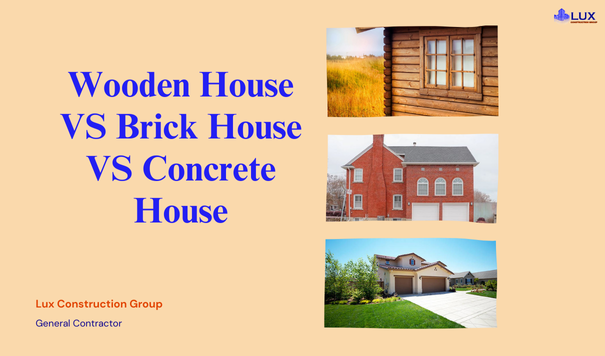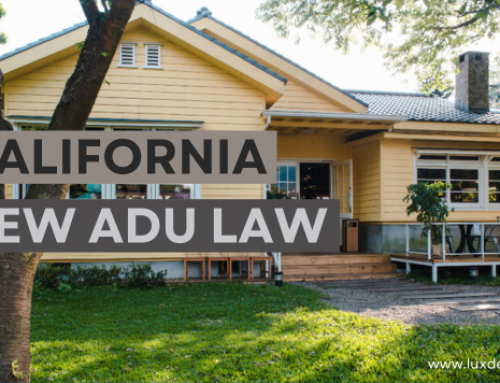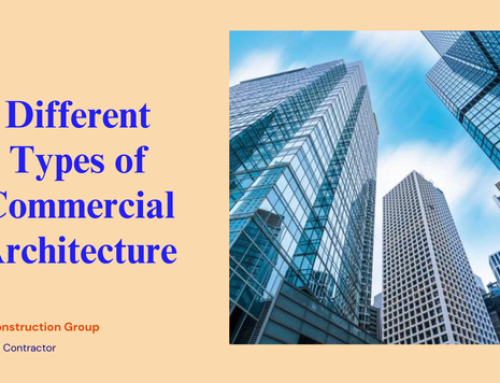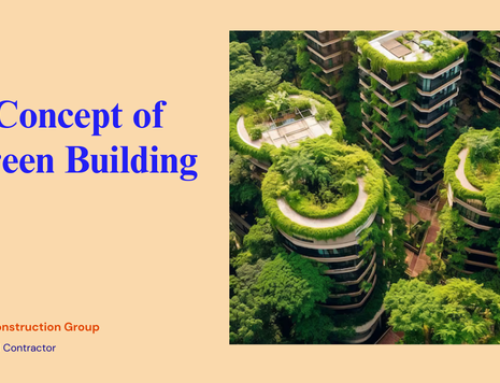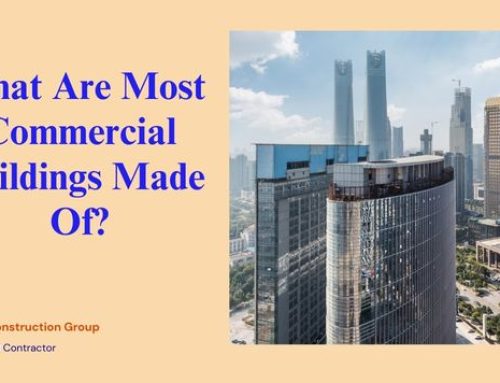Which house brings you the most joy and comfort – a wood, brick, or concrete one?
It’s a significant decision while planning for your next home. At LUX Construction Group, we understand that each material brings its unique set of advantages to the table.
Each material has distinct architectural styles and also brings its unique set of advantages to the foundation of your living space.
Wooden houses whisper tales of rustic charm and natural warmth, while brick homes echo with timeless elegance and enduring strength. Concrete houses, on the other hand, stand as modern fortresses, offering unparalleled durability and contemporary flair.
As leaders in the construction industry, we are committed to guiding you through this crucial decision-making process. Our expertise stretches across all three materials, ensuring that your final choice is not just a house, but a sanctuary tailored to your dreams.
Read this blog! Every section you cover is a step closer to the home you’ve always imagined.
Contents
- Wooden House, Brick House, VS Concrete House – Know The Difference!
- Wooden Houses
- Pros and Cons of Wooden Houses
- Ideal Conditions for Wooden Houses
- Maintenance and Longevity
- Brick Houses
- Pros and Cons of Brick Houses
- Ideal Conditions for Brick Houses
- Maintenance and Longevity
- Concrete Houses
- Pros and Cons of Concrete Houses
- Ideal Conditions for Concrete Houses
- Maintenance and Longevity
- Comparative Analysis: Wooden House, Brick House VS Concrete House
- Cost
- Durability and Safety
- Energy Efficiency and Insulation
- Customization and Aesthetic Appeal
- Adaptability to Styles and Climates
- Sound Insulation and Acoustic Performance
- Resistance to Natural Elements
- Construction Time and Flexibility
- Future Remodeling and Repairs
- Resale Value and Market Perception
- How to Choose The Right House For You
- Assessing Personal Needs and Preferences
- Location-Specific Considerations
- Budget and Long-Term Costs
- Future-Proofing and Resale Value
- LUX Construction Group – Build With Us!
Wooden House, Brick House, VS Concrete House – Know The Difference!
When it comes to building a home, the material you choose is crucial. Wooden, brick, and concrete houses each offer unique benefits and challenges.
Understanding these differences can help you make an informed decision about what’s best for your future home.
Wooden Houses
When considering the construction of a home, the choice of material plays a pivotal role in determining its aesthetics, durability, and comfort. Wooden houses, with their natural charm and warmth, have been a popular choice for centuries. Let’s explore more about it.
Pros and Cons of Wooden Houses
Pros:
- Aesthetic Appeal: Wooden houses have a timeless beauty, offering a range of styles from rustic log cabins to modern timber-framed structures. The natural texture and color of the wood create a warm and inviting ambiance.
- Insulation Properties: Wood is a natural insulator, keeping homes warm in winter and cool in summer. This can lead to significant energy savings over time.
- Eco-Friendly: Responsibly sourced wood is a renewable resource, making wooden houses a more environmentally sustainable choice compared to some other materials.
- Flexibility in Design: Wood is a versatile material that can be easily shaped and customized, allowing for unique architectural designs.
Cons:
- Susceptibility to Environmental Damage: Wood can be vulnerable to moisture, termites, and other pests. In humid or rainy climates, the risk of rot and mold increases.
- Maintenance Requirements: Wooden houses require regular maintenance, including staining, sealing, and protection against pests.
- Fire Risk: Wood is combustible, and therefore, wooden houses have a higher fire risk compared to non-combustible materials like brick or concrete.
Ideal Conditions for Wooden Houses
Wooden houses are particularly well-suited to certain environments. Dry climates are ideal, as there is less risk of moisture-related damage. Additionally, wood or rural settings not only complement the natural aesthetic of wooden homes but also provide easy access to timber, reducing transportation costs and environmental impact. Regions with a tradition of wooden construction often have the skilled labor necessary for building and maintaining these types of homes.
Maintenance and Longevity
The longevity of a wooden house largely depends on regular and effective maintenance. Here are key practices:
- Protective Coatings: Applying stains, paints, or sealants can protect wood from moisture and UV rays.
- Pest Control: Regular inspections and treatments are necessary to prevent infestations of termites and other wood-damaging pests.
- Moisture Management: Proper design and landscaping can prevent water accumulation around the structure, reducing the risk of rot.
- Regular Inspections: Annual checks for any signs of damage or wear are crucial for timely repairs.
With diligent care, a wooden house can last for many decades, becoming more than just a dwelling but a legacy passed down through generations. The choice of a wooden house, therefore, hinges not just on its aesthetic appeal but also on a commitment to its upkeep and a suitable environmental setting.
Brick Houses
Brick houses, with their blend of durability, safety, and timeless appeal, offer a compelling option for many homeowners. While the initial investment might be higher, the long-term benefits of low maintenance, energy efficiency, and enduring strength make them a wise choice for those looking for a permanent and secure home.
Pros and Cons of Brick Houses
Pros:
- Durability and Strength: Brick houses stand the test of time, often remaining intact and sturdy for centuries. This durability is a result of the inherent strength of fired clay bricks, which resist natural degradation.
- Fire Resistance: Bricks are inherently fire-resistant, offering an added layer of safety against fire hazards. This feature is particularly valuable in areas prone to wildfires or in urban settings where fire risks are higher.
- Low Maintenance: Brick homes are great due to their ease of maintenance. They resist common problems like rot, pests, and deformation that often affect wooden houses.
- Energy Efficiency: Thick brick walls provide natural insulation, maintaining a comfortable indoor temperature and reducing energy costs.
Cons:
- Higher Initial Cost: The cost of materials and construction for brick houses is generally higher than wooden or concrete alternatives.
- Less Flexibility for Modifications: Once built, brick structures are challenging to modify or expand, limiting flexibility for future changes.
- Potential for Moisture Issues: If not properly constructed or maintained, brick can absorb moisture, leading to dampness issues.
Ideal Conditions for Brick Houses
Brick houses excel in a variety of climates, but they are particularly well-suited for:
- Areas with Temperature Fluctuations: Bricks have excellent thermal mass, making them ideal for regions with significant temperature swings between day and night.
- Regions Prone to Harsh Weather: Their sturdiness makes them a reliable choice in areas prone to severe weather conditions, such as strong winds or heavy rains.
Maintenance and Longevity
- Mortar Joint Care: Regular inspection and repair of mortar joints are crucial in preventing water ingress and structural damage.
- Brick Cleaning: While bricks require minimal upkeep, occasional cleaning can prevent discoloration and moss growth, preserving the home’s aesthetic value.
- Efficient Drainage: Properly installed and maintained drainage systems are vital in preventing water accumulation that can lead to dampness and erosion in brick structures.
A brick house is not just a dwelling but a long-term investment. Its longevity extends beyond decades, often becoming a heritage structure. This durability translates into a higher resale value, making it a financially sound choice in the long run.
Concrete Houses
Concrete houses stand out for their strength, safety, and durability. While they may have higher initial costs and perceived aesthetic limitations, their long-term benefits in maintenance, energy efficiency, and resilience make them a compelling choice for many.
Pros and Cons of Concrete Houses
Pros:
- Durability and Strength: Concrete houses are synonymous with strength. Their ability to withstand severe weather, including hurricanes and tornadoes, makes them a safe choice in prone areas.
- Fire Resistance: Concrete’s non-combustible nature significantly reduces the risk of fire damage, enhancing safety for inhabitants.
- Pest Resistance: Unlike wood, concrete doesn’t attract termites or rodents, minimizing concerns about pest-related damages.
- Energy Efficiency: Thick concrete walls provide excellent insulation, keeping homes cooler in summer and warmer in winter, which can lead to energy savings.
- Sound Insulation: The density of concrete walls offers superior soundproofing, making these houses ideal for urban or noisy environments.
Cons:
- Aesthetic Limitations: Concrete can be perceived as less warm or inviting compared to wood. Creative design and interior decoration are essential to counter this.
- Initial Cost: The upfront cost of building a concrete house can be higher than other materials due to the cost of concrete and labor-intensive construction.
- Flexibility: Once constructed, concrete houses are harder to modify or expand compared to wooden or brick homes.
Ideal Conditions for Concrete Houses
Concrete houses are particularly well-suited for:
- Areas Prone to Extreme Weather: Their robustness makes them ideal in regions facing hurricanes, tornadoes, or earthquakes.
- Urban Settings: The soundproofing qualities of concrete are beneficial in noisy city environments.
- Varied Climates: Concrete’s insulation properties are advantageous in both hot and cold climates, offering year-round comfort.
Maintenance and Longevity
- Structural Stability: Concrete’s robust nature means less frequent repairs and structural issues.
- Resistance to Elements: Concrete is resistant to moisture, mold, mildew, and pests, significantly reducing the need for regular maintenance.
- Exterior Upkeep: The exterior typically requires only occasional cleaning, a simpler process compared to the maintenance required for wood or brick exteriors.
- Extended Lifespan: Concrete houses are known for their long lifespan, often exceeding a century with minimal structural problems.
- Aging with Grace: Unlike other materials, concrete doesn’t show age easily; it doesn’t warp, rot, or require frequent cosmetic repairs.
- Resilience to Weather: Its ability to withstand harsh weather conditions ensures the structural integrity of the house over time.
Comparative Analysis: Wooden House, Brick House VS Concrete House
When deciding between a wooden, brick, or concrete house, several key factors come into play. Understanding these can guide you in choosing the best option for your needs and preferences.
-
Cost
Wood: Generally, wooden houses are more cost-effective to build than brick or concrete houses. The materials and labor for wood construction are often less expensive. However, the long-term maintenance costs can be higher due to the need for regular treatments and repairs.
Brick: Brick houses have a higher initial construction cost compared to wooden houses. The durability of brick can lead to lower maintenance costs over time, making it a cost-effective choice in the long run.
Concrete: Concrete houses are usually the most expensive upfront due to the cost of materials and specialized labor. However, their longevity and minimal maintenance can offset these initial costs over time.
-
Durability and Safety
Wood: While offering aesthetic appeal, wooden structures can be vulnerable to fire, pests, and weather-related damage. However, modern treatments and building techniques have significantly improved their safety and durability.
Brick: Brick is known for its exceptional durability and fire resistance. It withstands weather extremes well, making it a safe choice in various climates.
Concrete: Concrete offers the highest level of durability and safety, being resistant to fire, pests, and extreme weather conditions, including earthquakes and hurricanes.
-
Energy Efficiency and Insulation
Wood: Wood naturally has good insulating properties, making wooden houses energy efficient, especially in colder climates.
Brick: Brick houses can have good insulation, but this often requires additional insulating materials to be as energy-efficient as wooden houses.
Concrete: Concrete provides excellent insulation against heat and cold, but its efficiency can be enhanced with additional insulation materials.
-
Customization and Aesthetic Appeal
Wood: Wooden houses offer a high degree of customization. Wood can be easily shaped, carved, and styled, making it ideal for unique architectural designs and personalization.
Brick: While brick offers a classic look, it also allows for versatility in design. Different brick colors, sizes, and laying patterns can create diverse and attractive aesthetics.
Concrete: Concrete is unparalleled in its flexibility for innovative designs. It can be molded into virtually any shape, allowing for contemporary and avant-garde architectural styles.
-
Adaptability to Styles and Climates
Wood: Wooden houses offer great versatility in design and can be adapted to various architectural styles. They perform best in dry climates but can be treated for use in more humid conditions.
Brick: Brick houses have a timeless appeal and can be designed to suit both traditional and modern aesthetics. They are well-suited for variable climates, offering natural insulation.
Concrete: Concrete is highly adaptable in terms of design, allowing for innovative architectural forms. It’s suitable for almost any climate, particularly areas prone to severe weather or high noise levels.
-
Sound Insulation and Acoustic Performance
Wood: Wood structures can offer good sound insulation, but they may require additional acoustic treatments to match the sound-dampening properties of denser materials.
Brick: Brick walls provide excellent sound insulation due to their density, making them ideal for homes in noisy environments.
Concrete: Concrete is highly effective in sound insulation, offering superior acoustic performance, which is beneficial in urban or noisy areas.
-
Resistance to Natural Elements
Wood: Wood is susceptible to damage from elements like moisture, termites, and other pests. However, with proper treatments and maintenance, these risks can be mitigated.
Brick: Brick is highly resistant to pest damage and rot, but it can be vulnerable to moisture absorption, leading to potential issues in very damp climates.
Concrete: Concrete offers excellent resistance to most natural elements, including pests, rot, and moisture, making it a robust choice in various environmental conditions.
-
Construction Time and Flexibility
Wood: Wood construction is generally faster than brick or concrete, as the materials are lighter and easier to work with. This can lead to shorter construction times and potentially lower labor costs.
Brick: Brick construction can be time-consuming due to the labor-intensive process of laying bricks. However, it offers a certain degree of flexibility in design alterations during the build.
Concrete: Concrete construction, especially when using precast panels, can be quick. However, once set, concrete offers little flexibility for changes.
-
Future Remodeling and Repairs
Wood: Remodeling and repairs on wooden structures are generally easier and less costly. Wood’s adaptability allows for easier renovations or expansions.
Brick: While durable, brick houses can be more challenging and expensive to modify or repair, especially when trying to match existing brickwork.
Concrete: Concrete is difficult to modify once set. Any future changes or repairs can be complex and costly compared to wood or brick.
-
Resale Value and Market Perception
Wood: Wooden houses can have a high resale value, especially in markets where wood is prized for its aesthetic and warmth. However, this can depend on the house’s condition and maintenance.
Brick: Brick houses generally maintain their value well, thanks to their durability and timeless appeal. They are often sought after in the real estate market.
Concrete: Concrete houses, particularly those with modern designs, can attract a premium in the housing market. Their durability and low maintenance needs are significant selling points.
How to Choose The Right House For You
When deciding between a wooden, brick, or concrete house, several key factors come into play. This decision is not just about aesthetics; it’s about aligning your choice with your lifestyle, financial goals, and long-term plans.
Let’s identify these considerations to help you make an informed decision.
-
Assessing Personal Needs and Preferences
Your personal preferences play a pivotal role in choosing the right house. Do you value the warm, rustic charm of a wooden house, the classic durability of brick, or the modern, robust nature of concrete?
Consider your lifestyle needs as well. For instance, if you’re someone who enjoys DIY projects, a wooden house might be more appealing due to its easier modifiability. On the other hand, if you prefer a low-maintenance home, concrete or brick might be more suitable.
-
Location-Specific Considerations
The location of your future home significantly influences the best material choice. In areas prone to extreme weather conditions like hurricanes or tornadoes, the sturdiness of concrete houses offers peace of mind.
However, in earthquake-prone regions like Los Angeles, San Andreas, etc., the flexibility of wooden structures can be advantageous. Additionally, consider the local climate – wooden houses are great for insulation in cold climates, while brick and concrete fare better in warmer areas.
-
Budget and Long-Term Costs
Your budget is a crucial factor. Generally, wooden houses can be less expensive to build but may incur higher maintenance costs over time.
Brick houses, while potentially more costly upfront, often have lower long-term maintenance costs.
Concrete houses, known for their longevity and minimal maintenance, can be a cost-effective option in the long run. It’s important to balance initial construction costs with ongoing maintenance and utility expenses.
-
Future-Proofing and Resale Value
Consider the future-proofing of your investment. Are the materials you’re choosing adaptable to future technologies and energy efficiencies?
For example, concrete houses can be easily integrated with modern insulation techniques for energy efficiency. Additionally, think about the resale value. Brick houses often retain their value due to their durability and timeless appeal.
Wooden houses, if well-maintained, can also fetch a good market price, especially in areas where they are sought after for their aesthetic and warmth.
LUX Construction Group – Build With Us!
As you weigh the options between wooden, brick, and concrete houses, remember that the journey to your ideal home is a partnership with the right construction team. Here, at LUX Construction Group, we believe the true magic lies not just in the material, but in the partnership.
At LUX Construction Group, we understand the unique qualities of wooden, brick, and concrete materials. Our team’s expertise ensures that your chosen material is utilized to its fullest potential, aligning with both your aesthetic preferences and practical requirements.
Quality is the cornerstone of LUX Construction Group. From the initial design to the final touches, we ensure every aspect of your home meets our high standards and your expectations. Your satisfaction is our priority, and we strive to make the construction process as seamless and enjoyable as possible.
With LUX Construction Group, you’re not just building a house; you’re crafting a space that will hold memories for generations. We invite you to embark on this exciting journey with us, where your vision, coupled with our expertise, creates a home that stands the test of time.
Contact LUX Construction Group. Let’s build a future together where every brick, beam, and corner resonates with your personal story.
Remember, a house is more than walls and a roof. So, let LUX Construction Group help you build yours.

